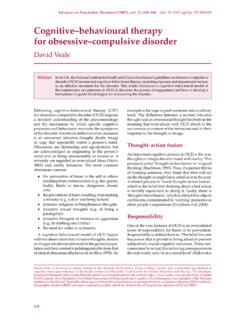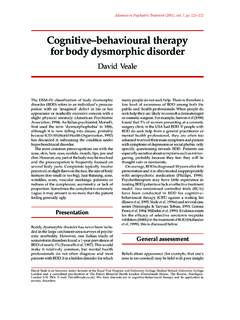Transcription of Treatment of social phobia - Professor David Veale
1 258 Advances in Psychiatric Treatment (2003), vol. 9. in Psychiatric Treatment (2003), vol. 9, 258 264 Treatment of social phobiaDavid VealeSocial phobia (or social anxiety disorder) consistsof a marked and persistent fear of social orperformance situations. Affected individuals fearthat they will be evaluated negatively or that theywill act in a humiliating or embarrassing to social or performance situationsinvariably leads to panic or marked anxiety, andsuch situations therefore tend to be avoided orendured with extreme phobia is the third most common mentaldisorder in adults worldwide, with a lifetimeprevalence of at least 5% (depending on thethreshold for distress and impairment). There isan equal gender ratio in Treatment settings, butin catchment area surveys, there is a female pre-ponderance of 3:2. Individuals are more likely tobe unmarried and have a lower socio-economicstatus.
2 Although common, social phobia is often notdiagnosed or effectively treated. There have,however, been a number of developments in ourunderstanding and Treatment of social phobia overthe past decade, and these are the focus of onset of social phobia usually takes placeduring adolescence, although a minority of causesinvolve a late onset after a significant life event (suchas an episode of failure). The typical course ischronic and life-long. Predisposing factors includea shy or anxious temperament from childhood. Thereis significant comorbidity, especially of depression,alcohol or substance misuse or body dysmorphicdisorder. In body dysmorphic disorder, patients areoften too ashamed to reveal their preoccupation withtheir appearance, and present with symptoms ofsocial anxiety and depression, fearing that themental health professional will view them as vainor narcissistic. A similar situation exists in patientswith olfactory reference syndrome, who believethat they have body odour that others will findunpleasant, which they may camouflage withperfume.
3 Therefore, all patients with symptoms ofsocial anxiety should be routinely asked whetherthey are very concerned about some aspect of theirappearance or about body odour. It should beemphasised that patients with social phobia do notlack social skills. Most affected individuals will havenormal social skills in a consultation with you, orwith a friend or partner. In social situations, theyare trying too hard and can appear to lack socialskills, because they might interact less, keep theirhead down or not reveal personal (for example, those with Asperger syn-drome) who do lack communication skills have adifferent presentation of social phobia can depend oncultural contexts. In Western cultures, patients mightpresent to surgeons for cures for complaints ofexcessive blushing or sweating. In Japan, socialphobia is manifested as an extreme fear of bringingoffence to others, and is referred to as taijin of this disorder may fear that makingeye contact, blushing, imagined defects in theirappearance or their body odour would be offensiveto Veale is an honorary senior lecturer at the Royal Free and University College Medical School and a consultant psychiatristat the Priory Hospital (The Bourne, Southgate, London N14 6RA, UK).
4 He has a special interest in cognitive behaviouraltherapy and its application to anxiety disorders and body dysmorphic phobia (or social anxiety disorder) manifests as a marked and persistent fear of negativeevaluation in social or performance epidemiology, diagnosis and psychopathology arereviewed, including clinical presentation, cultural aspects and the differences between agoraphobiaand social phobia . Behavioural treatments, including graded self-exposure and cognitive restructuring,are considered. A cognitive model of the maintenance of social phobia is discussed. It is hypothesisedthat attentional shifting towards imagery, safety behaviours and post-mortem analyses play a keyrole in symptom maintenance. The implications of this for Treatment are described, and guidelines forpharmacological Treatment are of social phobia259 Advances in Psychiatric Treatment (2003), vol. 9. core psychopathology in social phobia is a fearof negative evaluation in social and performancesituations.
5 It overlaps with the concept of shame,although the two sets of literature have largelyignored one other (Gilbert & Andrews, 1998). Socialanxiety is best described as the fear of feelingashamed ( of the emotions aroused and theirinterference in one s presentation) or the fear of beingshamed ( by the negative evaluation of oneselfand potential loss of rank), or phobia usually leads to avoidance ofsituations such as public speaking or talking to agroup, parties, meetings, eating or drinking inpublic, working or writing while being observed,telephone calls, intimacy or dating. Groups arenearly always more anxiety-provoking than is anindividual. Peers of the same age are usually moreanxiety-provoking than older individuals. Forheterosexual individuals, people of the oppositegender are usually more anxiety-provoking thanthose of the same gender. Sometimes individuals inauthority, especially at work, are more anxiety-provoking than individuals at the same tend to be two sub-types of social phobia generalised and non-generalised.
6 Generalised socialphobia is more disabling and involves a more diverserange of feared stimuli. Those affected by it includesome patients with avoidant personality disorderand it has a worse prognosis. Non-generalisedsocial phobia is associated with avoidance of alimited range of performance situations or inter-actions (such as public speaking), and this overlapswith performance anxiety in sexual social phobia is easier to treat, witha better person afraid of speaking in public would notreceive a diagnosis of social phobia if publicspeaking was not routinely encountered and theperson was not particularly distressed about it. It isusually the degree of distress or impairment thatwarrants a diagnosis of social phobia , and thepossible indicators need to be considered in theappropriate context. For example, transient or mildsocial anxiety is especially common in degree of severity in social phobia is veryvariable, ranging from individuals who are virtuallyhousebound and have never had a relationship, toothers who are highly functioning except in certainareas such as making a presentation, which theyfind very distressing and which handicaps them intheir phobia might be confused with agora- phobia .
7 Individuals with agoraphobia tend tobe female and to be anxious about their physicalor mental health. They misinterpret physicalsensations as evidence of an immediate catastropheto their health. Panic attacks in agoraphobia tend tobe both situational and spontaneous. Affectedindividuals are concerned with a wider range ofautonomic sensations such as palpitations andfeeling dizzy or short of breath. Those with socialphobia, however, are more likely to be concernedwith autonomic sensations of blushing, shaking orstammering (which the person believes may benoticeable to others). Panic attacks in social phobiaoccur almost exclusively in social situations. Some-times, a patient with agoraphobia also has comorbidsymptoms of social anxiety. For example, he mightbelieve that he will collapse or go mad as a result ofa panic attack, but in a social situation, he mightalso fear causing a scene and others evaluating himnegatively.
8 Typical beliefs in an individual withsocial phobia focus on the perceived negativeevaluation by others of revealing a flaw or un-acceptable behaviour (for example, the personbelieves that her hands will shake or she will soundstupid or boring). This is also referred to in theliterature as external shame .Such individuals tend to have high standards orrules about how they must perform in socialsituations. Their assumption is that failing toachieve these standards might lead others to seethem as inferior, flawed or inadequate and they them-selves also agree with this assessment (referred toas internal shame ). They predict that this failurewill lead to rejection or a further failure to achievean important goal. Individuals with no internalshame may know that others are rejecting them andview them as inferior, but not believe it emotions in social phobia are predominantlythose of anxiety and shame, and sometimes self-disgust or anger (which will depend on beliefs andsafety behaviours).
9 As in other anxiety disorders,the main coping (or defensive) behaviour is to escapefrom the situation. There is a strong urge not to beseen. Eye gaze is commonly averted and there isbehavioural inhibition (discussed in more detailbelow under safety behaviours ). These behav-iours might be linked to the submissive defensivebehaviours used to reduce aggression in anotherperson in response to the threat of the focus is on another person as being badand doing something to expose the individual asinferior, then the main emotion is of humiliation(rather than social anxiety). There is a sense ofinjustice and unfairness, often leading to anger anda strong desire for revenge against the one who isexposing the self as weak or and other substances are commonly usedin social phobia , but such usage might result in aself-fulfilling prophecy as patients may indeed make260 Advances in Psychiatric Treatment (2003), vol.
10 9. individual s own evaluation of his or herbehaviour that is crucial in determining the degreeof social anxiety. Such alternative approaches arenot usually recommended, as adherence is likely tobe poor unless the therapist is prepared to modelthe behaviour. Self-exposure and variants ofcognitive restructuring are effective and validtreatments, but the Treatment gains might only bemodest. For example, Heimberg et al (1990) reportthat only 65% make clinically significant change .Cognitive therapyClark & Wells (1995) and Clark (2001) havedeveloped a cognitive model for the maintenance ofsocial phobia (Fig. 1). Most of the material for therest of this article is derived from their aim of the model is to answer the question ofwhy the fears of someone with social phobia aremaintained despite frequent exposure to social orpublic situations and the non-occurrence of thefeared catastrophes. Recent research from controlledtrials supports the efficacy of the approach (Clarket al, 2003).








